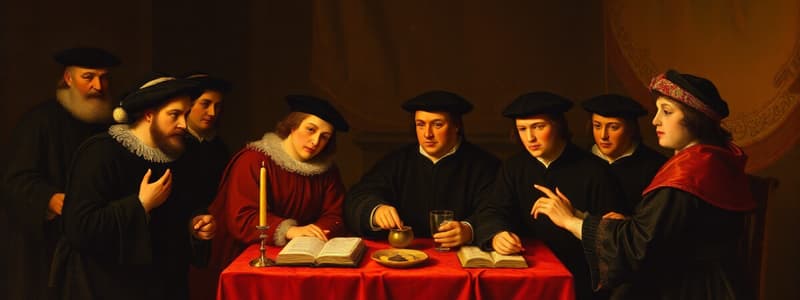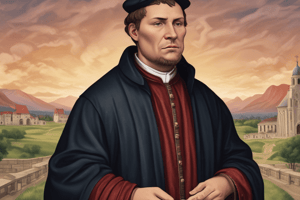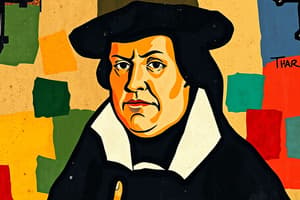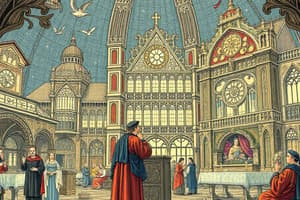Podcast
Questions and Answers
What primary factor enabled the revolutionary ideas of the Renaissance and Reformation to spread rapidly throughout Europe?
What primary factor enabled the revolutionary ideas of the Renaissance and Reformation to spread rapidly throughout Europe?
- Increased patronage of the arts by the Catholic Church.
- The rise of powerful monarchies willing to support intellectual pursuits.
- A decline in feudalism, leading to greater social mobility and exchange of ideas.
- The invention of the printing press, which allowed for quick and cheap dissemination of information. (correct)
Which of the following best describes the core belief of humanism during the Renaissance?
Which of the following best describes the core belief of humanism during the Renaissance?
- Focus on human potential and achievements, celebrating individual merit and classical values. (correct)
- Emphasis on religious dogma and strict adherence to Church teachings.
- Belief in predestination and the insignificance of human actions.
- Rejection of classical texts in favor of medieval scholasticism.
In what way did the Renaissance mark a shift from medieval values?
In what way did the Renaissance mark a shift from medieval values?
- Reduced interest in classical texts and learning.
- Decline in artistic expression and creativity.
- Increased emphasis on spiritual and religious devotion.
- Greater focus on worldly pleasures and material luxuries. (correct)
Which of the following is an example of how Renaissance art differed from that of the Middle Ages?
Which of the following is an example of how Renaissance art differed from that of the Middle Ages?
Why was Italy the birthplace of the Renaissance?
Why was Italy the birthplace of the Renaissance?
How did the bubonic plague inadvertently contribute to the Renaissance?
How did the bubonic plague inadvertently contribute to the Renaissance?
What role did patrons play in the Renaissance?
What role did patrons play in the Renaissance?
What was the significance of writing in the vernacular during the Renaissance?
What was the significance of writing in the vernacular during the Renaissance?
In what ways did the Northern Renaissance differ from the Italian Renaissance?
In what ways did the Northern Renaissance differ from the Italian Renaissance?
What was the focus of Christian humanism?
What was the focus of Christian humanism?
How did the invention of the printing press affect the spread of literacy?
How did the invention of the printing press affect the spread of literacy?
What was the main idea of Thomas More's book, Utopia?
What was the main idea of Thomas More's book, Utopia?
What was the role of women in the Reformation?
What was the role of women in the Reformation?
What was a key belief of Martin Luther that differed from the Catholic Church?
What was a key belief of Martin Luther that differed from the Catholic Church?
What was the main idea of an indulgence?
What was the main idea of an indulgence?
What was the significance of Luther's trial at the Diet of Worms?
What was the significance of Luther's trial at the Diet of Worms?
Why did King Henry VIII break from the Catholic Church?
Why did King Henry VIII break from the Catholic Church?
Which actions characterized Elizabeth I's approach to religious conflict in England:
Which actions characterized Elizabeth I's approach to religious conflict in England:
Which of the following reflects John Calvin's concept of predestination?
Which of the following reflects John Calvin's concept of predestination?
How did Calvin's leadership in Geneva impact that city?
How did Calvin's leadership in Geneva impact that city?
What did the Anabaptists believe?
What did the Anabaptists believe?
What was the main goal of the Catholic Reformation?
What was the main goal of the Catholic Reformation?
What were the main focus of the Jesuits?
What were the main focus of the Jesuits?
How did the Council of Trent aim to strengthen the Catholic Church?
How did the Council of Trent aim to strengthen the Catholic Church?
What did the legacy of the Reformation do?
What did the legacy of the Reformation do?
In what ways did the Renaissance contribute to the religious changes of the Reformation?
In what ways did the Renaissance contribute to the religious changes of the Reformation?
Looking at how the leaders behaved, what can be gathered from that historical information:
Looking at how the leaders behaved, what can be gathered from that historical information:
How did the Northern Renaissance begin
How did the Northern Renaissance begin
What was the impact that printing had on society?
What was the impact that printing had on society?
How does one become a "Renaissance man?"
How does one become a "Renaissance man?"
In what ways did new technologies impact the spread of knowledge?
In what ways did new technologies impact the spread of knowledge?
What changes happened throughout the timeline as it relates to the Renaissance?
What changes happened throughout the timeline as it relates to the Renaissance?
How did ideas spread throughout the countries?
How did ideas spread throughout the countries?
During the reformation, what practices did people disagree with?
During the reformation, what practices did people disagree with?
Flashcards
Renaissance cultural interaction
Renaissance cultural interaction
Trade with the East and rediscovery of ancient texts spurred new cultural and artistic ideas.
The Reformation
The Reformation
Martin Luther's reform movement led to the creation of non-Catholic churches.
The printing press
The printing press
This invention allowed for faster, cheaper production of books and pamphlets, spreading new ideas rapidly.
Renaissance definition
Renaissance definition
Signup and view all the flashcards
Humanism definition
Humanism definition
Signup and view all the flashcards
Secular definition
Secular definition
Signup and view all the flashcards
Patron definition
Patron definition
Signup and view all the flashcards
Perspective in art
Perspective in art
Signup and view all the flashcards
Vernacular definition
Vernacular definition
Signup and view all the flashcards
Utopia definition
Utopia definition
Signup and view all the flashcards
Indulgence definition
Indulgence definition
Signup and view all the flashcards
Reformation definition
Reformation definition
Signup and view all the flashcards
Lutheran definition
Lutheran definition
Signup and view all the flashcards
Protestant definition
Protestant definition
Signup and view all the flashcards
Peace of Augsburg
Peace of Augsburg
Signup and view all the flashcards
Annulment definition
Annulment definition
Signup and view all the flashcards
Theocracy definition
Theocracy definition
Signup and view all the flashcards
Predestination definition
Predestination definition
Signup and view all the flashcards
Presbyterian definition
Presbyterian definition
Signup and view all the flashcards
Anabaptist definition
Anabaptist definition
Signup and view all the flashcards
Catholic Reformation definition
Catholic Reformation definition
Signup and view all the flashcards
Jesuits definition
Jesuits definition
Signup and view all the flashcards
Council of Trent
Council of Trent
Signup and view all the flashcards
Study Notes
European Renaissance and Reformation (1300-1600)
- This era led to new ideas about culture and art due to trade with the East and the rediscovery of ancient manuscripts
- The Renaissance means rebirth
Martin Luther and the Reformation
- Martin Luther initiated a movement which sought to reform the Catholic Church
- This movement, known as the Reformation, resulted in the creation of non-Catholic churches
- It was facilitated by the printing press
The Madonna of Chancellor Rolin
- The painting by Jan van Eyck can tell us about the Renaissance
- The columns in the painting show classical style
- Oil paints were a new invention
- The painting depicts the continuing importance of religion
- Chancellor Rolin's robe indicates his status as an individual was also of importance
- Details were added simply to add beauty
Italy: Birthplace of the Renaissance
- The Italian Renaissance caused an explosion of creativity in art, writing, and thought that lasted from approximately 1300 to 1600
- Renaissance means rebirth, referring to a revival of art and learning
- Educated Italians aimed to revive the culture of classical Greece and Rome
- They created innovative styles of art, literature, and new values like the importance of the individual
- Renaissance eventually spread from northern Italy to the rest of Europe
- Italy held the advantages of thriving cities, a wealthy merchant class, and classical heritage
- City-states in northern Italy grew due to overseas trade spurred from the Crusades
- Northern Italy was more urban compared to the rest of Europe
- Cities provided a place for exchange of ideas, breeding an intellectual revolution
- Bubonic plague struck hard in the 1300s and encouraged new interests as labor was limited
Merchants and the Medici
- A wealthy merchant class developed in each Italian city-state
- Merchants used their wits to succeed in business
- They believed they gained because of individual merit.
- Cosimo de Medici, the wealthiest European of his time, gained control of Florence in 1434
- He influenced the council by offering loans.
- The Medici family continued to control Florence after Cosimo died
- Lorenzo de Medici, Cosimo's Grandson, ruled with the appearance of an elected official
Renaissance Values
- Renaissance scholars looked down on the art and literature of the Middle Ages
- Italy's artists and scholars took inspiration from Roman Ruins and Western scholars preserving manuscripts
- The Turks conquering constantinople sent Christian scholars fleeing with Greek texts
- Humanism is an intellectual movement focused on human potential and achievements.
- Humanists studied classical texts to understand ancient Greek values, influencing artists and architects
- History, literature, and philosophy are subjects common to classical education
- Humanists suggested enjoyment of life without offending God
- The basic spirit of Renaissance society was secular—worldly rather than spiritual
- Church leaders during the Renaissance became patrons of the arts by beautifying Rome and other cities
Renaissance Men and Women
- Financially supporting artists allowed Renaissance merchants and families to become Patrons
- Renaissance writers introduced the idea that all educated people were expected to create art
- The ideal man was "universal", mastering almost every area of study
- Baldassare Castiglione wrote The Courtier (1528) that taught how to become a Renaissance Man
- The Renaissance Man should be charming, witty, educated, dance, sing, play music, write poetry, ride, wrestle, and sword fight
- Upper-class women should know the classics and be charming, but not seek fame, but inspire art
- Upper-class Renaissance women were better educated than medieval women
- Most Renaissance women had little influence in politics
- Isabella d'Este of Ferrara married the ruler of Mantua, brought Renaissance artists to her court, built an art collection, and defended Mantua in war
The Renaissance Revolutionizes Art
- Patrons like Isabella d'Este supported dozens of artists in Northern Italy
- Artistic styles changed during the Renaissance.
- Medieval artists conveyed spiritual ideals with religious subjects
- Renaissance artists depicted religious subjects realistically and copied classical models
- Greek and Roman subjects became popular and Perspective in art
- Painters began to paint realistic portraits, revealing what was distinctive about each person
- Michelangelo Buonarroti depicted the human body realistically
- Donatello made sculpture more realistic by carving natural postures and expressions
- Donatello's statue of David was created in the late 1460s
- Renaissance sculptors were partial to the subject of David
Perspective Art
- It creates the appearance of 3 dimensions by creating an optical illusion
- Parallel lines stretch away from a viewer, and meeting at a spot on the horizon called the vanishing point
- Perspective was a feature of most Western painting for the next 450 years
Renaissance Figures
- Leonardo da Vinci was a painter, sculptor, inventor, and scientist.
- Leonardo made observations and sketches, incorporating findings in his art
- Leonardo da Vinci painted the Mona Lisa and produced The Last Supper
- Raphael Sanzio was younger than the other two masters, painting the Madonna and filling Pope Julius' library with paintings
- The 2 female renaissance figures Anguissola and Gentileschi were very influential
Renaissance Writers
- Writers produced works and wrote in the vernacular
- Petrarch was one of the earliest and most influential humanists, as well as a great poet
- Giovanni Boccaccio know best for The Decameron
- Niccolò Machiavelli wrote The Prince (1513), holding the controversial opinion that great leaders shouldn't act honorably, but that it may be politically effective
Global Patterns in Renaissance Times
- In addition to the Italian Renaissance, rebirths and revivals occurred in other areas of the world
- The Tang and Song dynasties in China also saw great periods of artistic and technological advancement
- Roots in earlier time, the Han Dynasty and post-war of that Dynasty were similiar to the roots of the Italian time period
Renaissance Assessment
- Renaissance: A period of European history marking a cultural rebirth
- Humanism: An intellectual movement that emphasized human potential and achievements
- Secular: Worldly rather than spiritual; concerned with the here and now
- Patron: A person who financially supports artists
- Perspective: A technique in painting that shows three dimensions on a flat surface
- Vernacular: The native language of a region or country
- Utopia: An ideal or perfect place or society, often portrayed in literature
- William Shakespeare: A famous English playwright and poet of the Elizabethan Era
- Johann Gutenberg: A German craftsman who developed a printing press in the mid-1400s with movable type
The Northern Renaissance
- In the 1400 Ideas of the Italian Renaissance began to spread to Northern Europe due to a strong part of modern thought. It was led by Northern figures who helped the poor improve their value which was considered previously only for Southern figures
Art Spreads to the North
- Styles blended and traditions improved as Northern Europe became more popular through Italian Renaissance.
- Artists grew in areas like Realism as human dignity improved and plans began. For this reason, people were interested in the values of Christian belief. During this time, many Northern European people sought to create art that reflected God
- In this section, the figure Albrecht Dürer grew in the area of realism and realism inspired emphasis upon portraits.
Writers Try To Reform
- The idea of classical language was used but people wanted traditional teaching. Movement of Christian humanism. Humanists promoted women's education as well as built schools for girls and boys. In this section, The Praise of Folly and Utopia pushed people to think and question more
- Authors questioned everything and worked to create new methods that made society more enjoyable and that would bring forth reform
- Christine de Pizan also wrote about objections about men educating women in The Book Of The City Of Ladies
Elizabethan Era
- Renaissance spread with Queen Elizabeth who reigned in the English renaissance
- She supported English art and literature's development as she supported her writing with music and poetry
- Shakespeare's fame came in that that Era as people revered the classics and drew on them for inspiration He delivered characters through the human experience and his work showed a high view of human nature
Printing Spreads Ideas
- During this area, both Asia and Europe spread ideas regarding the press with the Chinese creating paper and the movable type creating letters
- People wanted more methods so they learned and wrote Bibles
- Gutenberg then improved a method through this that would allow books to be made quickly and cheaply and this would prove to be the first method for a full sized book
Reformation of the Press
- Printing presses enabled printers to have hundreds of copies of a single work causing the opportunity of cheap books for many
- Printers produced mainly religious text and then travel guides and medical manuals came
- Ideas shifted through here to promote the values of family and community. Also the idea that women had to stay in the houses to prevent "roaming eyes"
Reformation Assessment
- Utopia is an Ideal society where individuals are safe and happy
Luther v England
- Germany and the English, lead, the religion was not pure. The main disagreement was that England made divorce accepted within the church
Reformation in 1500
- Renaissance emphasis in political life brought question in life and the Renaissance and the printing press
- Some leaders are corrupt while people want the sale to stop. All of these factors are related to the reformation
Luther the Leader
- Inspired that his people be allowed to read bible and that people should seek the right bible, Luther led to being
- In reaction to this, the church burned his books.
Dividing Religions
- There was not much understanding about if all of the things that came in in the 16th century with leadership by God. Due to all the different reasons in belief, the religions split. Those in power began hating the new people who spoke their mind as they were called heretics.
- Reformers helped to spread new ideas and a question lead the reformers from early stages of the renaissance forward to many.
Legacy
- Great artistic time and social change made all people equal. With that, their was power shifts to the leader as Europe became culturally Divided and religious
Analyzing Key Concepts
- Protestant: Branch of Christianity against beliefs that developed the Catholic Churches in the 16th Century
Assessment of Key Terms
- Renaissance - A period of artistic and intellectual rebirth in Europe after the Middle Ages
- Vernacular - The use of everyday language rather than classical Latin in literature and education
- Utopia - An imagined perfect or ideal society
- Reformation - A 16th-century movement for religious reform, leading to the establishment of Protestant churches
- Protestant - A member of a Christian church founded on the principles of the Reformation
- Peace of Augsburg - An agreement in 1555 declaring that the religion of each German state would be decided by its ruler
- Catholic Reformation - A 16th-century movement in which the Roman Catholic Church sought to make changes in response to the Protestant Reformation
- Council of Trent - A meeting of Roman Catholic leaders, called by Pope Paul III to rule on doctrines criticized by the Protestant reformers
Summary
- The Renaissance caused new dramatic change to modern society. In religion and how modern art displays it. Also changed the way humanism and education for everyone was important.
Studying That Suits You
Use AI to generate personalized quizzes and flashcards to suit your learning preferences.




